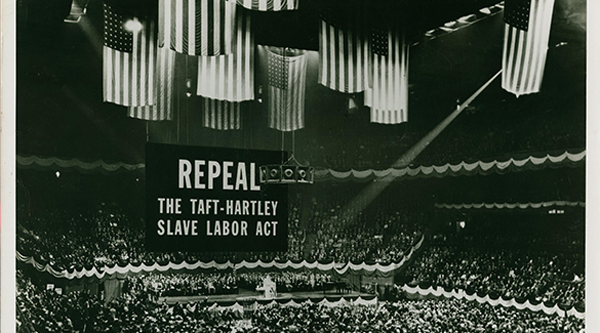
As hard as workers have fought for their rights, we know that what we win can be lost if we don’t stay strong and protect the gains we make. The UBC has been a key player in every major campaign on behalf of workers since our founding in 1881. Here are some highlights.
In the U.S.
Union Rights
More than 100 years after the first carpenters to arrive in the U.S. began organizing, Congress passed the National Labor Relations Act (NLRA) in 1935. Also called the Wagner Act, the NLRA gave legal protection to workers trying to organize and established a system for forming unions and bargaining with employers.
Employers and anti-worker politicians ferociously opposed the NLRA and, 12 years later, succeeded in passing the Taft-Hartley Act, which weakened workers and unions by prohibiting several kinds of strikes and boycotts—and allowing individual states to pass anti-worker “right-to-work” laws. Right-to-work remains a major battleground issue, as laws have now been passed in 27 states. Union rights, wages, working conditions and safety all suffer in right-to-work states.
Wage Protection
The UBC’s political clout in Congress helped to pass the Davis-Bacon Act in 1931, which mandates that when the federal government finances a construction project in an area, it must pay workers according to that area’s “prevailing” wages. This makes it impossible to use federal projects to drive down local wages and maintains living standards for construction workers.
In almost every session of Congress since its passage, attempts have been made to weaken Davis-Bacon, but the UBC has worked hard to build a coalition of supporters in both political parties. (See Page 9 for the latest Davis-Bacon news.)
Prevailing wage laws in 32 states accomplish the same goals. They are sometimes called “Little Davis-Bacon” laws.
Safety and Health
Unions were the key to establishing the Occupational Safety and Health Administration (OSHA) in 1970. OSHA educates workers and employers and sets standards governing safety and health on the job, enforcing them through worksite inspection. Twenty-two states have their own safety and health agencies.
Other Key Gains
Several other laws and agencies protect workers, including the Employment and Retirement Security Act (ERISA); the Americans with Disabilities Act (ADA), and the Equal Employment Opportunity Commission.
In Canada
Union Rights and Working Conditions
Workers agitated for their rights in Canada as early as the 1850s, with a focus on shorter work hours. The prime minister introduced the Trade Union Act in 1872, legalizing and protecting unions, and a royal commission on labor strongly defended unions and urged improvements in safety and working conditions in its 1889 report.
A pivotal moment in Canadian labor history came in 1919, when UBC Local 343 member George Armstrong was jailed for organizing the Winnipeg General Strike for fair wages. It was the largest general strike in Canadian history and set the stage for future reforms.
At the federal level, the Canada Labour Code was enacted in the 1960s and governs workers’ rights to organize and bargain, maintains workplace health and safety regulations and governs employment conditions like wages and hours.
In 2007, the Supreme Court of Canada issued a landmark decision, ruling for the first time that collective bargaining is protected under the Canadian Charter of Rights and Freedoms.
In the run-up to the federal election in 2015, UBC members and all unions fought against the Conservative government’s anti-union Bill C-377—an unconstitutional attack on union rights and freedom of association. Within days of being elected, the Liberal government repealed Bill C-377.